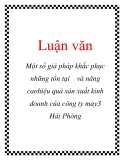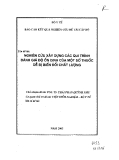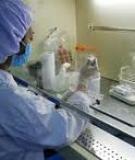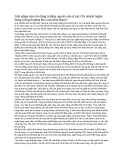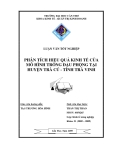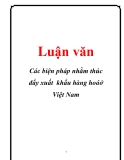Original article
Stomatal and non stomatal limitation of photosynthesis by leaf water deficits in three oak species: a comparison of gas exchange and chlorophyll a fluorescence data
D Epron E Dreyer
INRA-Nancy, Laboratoire de Bioclimatologie et d’Écophysiologie Forestières, Station de Sylviculture et Production, Champenoux, F-54280 Seichamps, France
(Received 5 April 1990; accepted 6 June 1990)
Summary — Net CO2 assimilation (A), stomatal conductance for CO2 (g), intercellular mole fraction of CO2 (Ci), kinetics of chlorophyll a fluorescence, and their half decay time (t1/2), their ratio of fluo- rescence decrease (Rfd), and their adaptive index (Ap) have been monitored on potted trees from 3 oak species (Quercus petraea, Q pubescens and Q ilex) grown in a climate chamber and submitted to drought. Use of A vs Ci representations for photosynthesis data revealed an apparent impairment of mesophyll photosynthesis, together with reduced CO2 supply to mesophyll due to stomatal clo- sure. But in all species chlorophyll a fluorescence kinetics displayed very similar shapes, constant t1/2 and stable Rfd and Ap values until predawn leaf water potential dropped below -4.0 MPa. These observations led to the conclusion that photochemical energy conversion and photosynthetic carbon reduction cycle could be very resistant to leaf water deficits, and that observed decreases in meso- phyll photosynthesis had to be attributed to a possible artefact in Ci calculation. On the other hand, the susceptibility of leaves to photoinhibition increased as a consequence of water shortage, espe- cially in Q petraea and Q pubescens. Differences in drought adaptation between the studied species could probably be related to susceptibility to photoinhibition rather than to a direct sensitivity of pho- tosynthesis to leaf water deficits, at least in the range of stress intensities of ecophysiological signifi- cance.
photosynthesis / water stress / chlorophyll a fluorescence / oak / stomatal conductance / drought / photoinhibition
* Correspondence and reprints. Abbreviations : A = net CO2 assimilation rate; Amax = A at saturating Ci; A = adaptative index; Ci = intercellular CO2 molar fraction; dA/dCi = carboxylation efficiency; Fp and Ft = maximal and terminal fluorescence levels; g = stomatal conductance for CO2; LWC = leaf water content; Pi = inorganic phosphate; PPFD = photosynthetic photon flux density; PSII and PSI = photosystem II and I; Rfd = ratio of fluorescence decrease; t1/2 = fluorescence half-decay time; a = apparent quantum yield of photosynthesis; ψwp = predawn leaf water potential; Δw : leaf to air water vapour molar fraction differ-
ence
Résumé — Limitation d’origine stomatique et non stomatique de la photosynthèse de trois espèces de chêne soumises à la sécheresse : comparaison de mesures d’échanges gazeux et de fluorescence de la chlorophylle. Les échanges gazeux foliaires et la fluorescence de la
chlorophylle ont été étudiés lors d’une sécheresse édaphique imposée en conditions contrôlées, sur de jeunes plants de Quercus patraea, Q pubescens et Q ilex. L’analyse des relations entre assimila- tion nette de CO2 (A) et fraction molaire intercellulaire calculée de CO2 (Ci) semble indiquer que l’inhibition de A a résulté à la fois d’une fermeture des stomates, mais aussi d’une altération des pro- cessus mésophylliens de la photosynthèse. Par contre, la forme des cinétiques de fluorescence de la chlorophylle réalisées in vivo ainsi que les valeurs de t1/2 (temps de demi décroissance), Rfd (rapport de décroissance de fluorescence) ou de Ap (index d’adaptation) n’ont pas été affectées tant que le déficit hydrique foliaire n’avait pas atteint un niveau élevé (potentiel hydrique de base inférieur à -4,0 MPa). Ceci semble indiquer une grande résistance de l’appareil photosynthétique au déficit hydrique foliaire. Par contre, l’étude de la réaction de la photosynthèse aux forts éclairements a révélé une sensibilité accrue à la photo-inhibition chez Q petraea et Q pubescens lors d’une sécheresse éda- phique, contrairement à ce qui a été observé pour Q ilex. Les différences d’adaptation à la séche- resse existant en conditions naturelles entre ces 3 espèces pourraient être due à une sensibilité ac- crue à la photo-inhibition plutôt qu’à une sensibilité directe de l’appareil photosynthétique au déssèchement foliaire, du moins dans la gamme des déssèchements les plus fréquemment rencon- trés en conditions naturelles.
photosynthèse / stress hydrique / fluorescence / chêne / conductance stomatique / séche- resse / photo-inhibition
INTRODUCTION
Some studies with chloroplastic suspen- sions or enzyme extracts have reported the occurrence of both reductions in photo- chemical processes (Boyer, 1976) and in ribulose-biphosphate carboxylase-oxygen- ase activity (Vu et al, 1987).
European oak species grow in habitats dif- fering widely in the frequence of drought occurrence. Quercus petraea (subgenus Lepidobalanus section robur), as a meso- phytic mid European species is rather sen- sitive to water shortage, while Q pubes- cens (subgenus Lepidobalanus section robur) grows in much drier soils. Q ilex (subgenus Lepidobalanus section ilex), a Mediterranean sclerophyllous xerophyte, is sometimes submitted to long periods of water deficits accompanied by high levels of solar irradiance.
Leaf gas exchange measurements and analysis using diffusion models (Jones, 1973, 1985; Farquhar and Sharkey, 1982) have frequently led to the result that leaf water deficits impair both mesophyll ability to assimilate CO2, and CO2 diffusion to chloroplasts (Jones and Fanjul, 1983; Tes- key et al, 1986; Cornic et al, 1987; Grieu et al, 1988). In these studies, net assimilation was analysed as a function of calculated intercellular CO2 mole fraction (Ci); in al- most all stress situations, reductions seemed to occur at fairly constant Ci val- ues, therefore displaying both diffusional and biochemical limitations of photosynthe- sis (Jones, 1973, 1985; Comic et al, 1983). However, recent results suggest that this model may be misleading, due to artefacts in Ci calculation (Terashima et al, 1988).
In order to test potential limitations in- duced by water stress on carbon assimila-
Differences in drought tolerance be- tween species may be partly due to differ- ential sensitivities of photosynthetic pro- cesses in leaves to tissue dehydration. But it is still unclear whether water shortage and resulting leaf water deficits have direct effect on the mesophyll processes of pho- tosynthesis (photochemical energy conver- sion and/or carbon metabolism), or only in- direct effects via stomatal closure and subsequent limitations of CO2 diffusion to chloroplasts.
Ventoux, near Avignon, France) and Q pubes- cens Willd (seed origin: Mont Ventoux).
tion of leaves in vivo on our 3 oak species, we compared the results obtained with gas exchange measurements and with chloro- phyll a fluorescence kinetics.
Three-year-old (Q pubescens and Q ilex) or 4-year-old (Q petraea) saplings were grown in 7-I plastic pots on a 1:1 (v/v) mixture of brown peat and sandy soil, in a naturally illuminated greenhouse; they were fertilised 4 times a year during the growing season with a complete nutri- ent solution (N,P,K; 7,6,9; Solugene), and were watered twice a week with deionized water.
Experimental time course
Chlorophyll a fluorescence kinetics, based on the Kautsky effect, allow the as- sessment to be made of possible impair- ments in: - energy conversion at PSII level (variable fluorescence); and - in the transfer of electrons from the first acceptors to the photosynthetic carbon re- duction cycle (fluorescence decrease) (Krause and Weis, 1984; Briantais et al, 1986). In this study, we analysed the shapes of fluorescence decrease which is related to the onset of both photochemical and non photochemical quenching, and calculated the half decay time t1/2, the ratio of fluorescence decrease (Rfd; Lichthen- thaler et al, 1986) and an adaptative index reflecting the degree of integrity of photo- synthetic membranes (Ap; Strasser et al, 1987). In addition, water stress often pro- motes susceptibility to photoinhibition (Krause, 1984). Susceptibility to photoin- hibitory damages has therefore been com- pared in our species and related to the lev- el of drought tolerance.
The aims of these experiments were to give an insight into the mechanisms of stress reactions, and to compare them in the 3 tree species known for their differ- ences in drought tolerance.
MATERIAL AND METHODS
Plant material and growth conditions
One week before each experiment, the plants were transferred to a growth cabinet with follow- ing day/night conditions: 16/8 h; air temperature, 22/16 °C; relative humidity, 70/95 %. Photosyn- thetic photon flux density (PPFD) at the top of the plants was maintained at 300 μmol m-2 s-1 provided by neon lamps. Ambient CO2 molar fraction averaged 475 ± 25 μmol mol-1.
Measurements were performed during May 1989 for Q pubescens, June 1989 for Q petraea and July 1989 for Q ilex. For each species, 2 control saplings were watered daily and 4 or 5 plants were exposed to water shortage by with- holding irrigation for about 20 d. Small amounts of water were added to the pots when needed, to avoid death of plants. Predawn leaf water po- tential, net CO2 assimilation rate and chlorophyll fluorescence kinetics were studied 2 d a week for the water-stressed plants and only 1 d a week for the control. At the end of the stress pe- riod, a twig of 2 control and of 2 or 3 drought- stressed plants was exposed for 4 h to a PPFD of 2 000 μmol m-2 s-1 provided by a sodium lamp (SON-T-400W, Philips) in order to assay susceptibility to photoinhibition. An electric fan was used to prevent thermal injury to the leaves. Apparent quantum yield of photosynthesis (a) and chlorophyll fluorescence were used to quan- tify possible photoinhibitory effects. To investi- gate the effect of rapid dehydration on chloro- phyll fluorescence kinetics, 20 leaf discs were punched from a twig of a well-watered plant of Q petraea. Five leaf discs were kept on a wet filter paper and 15 were submitted to dehydration in air for several h. This stress treatment was im- posed in darkness at room temperature (≈ 20 °C). The oak species studied were Quercus petraea Liebl (seed origin: Forêt Domaniale d’Amance, near Nancy, France), Q ilex L (seed origin: Mont
Water relations
PPFD) response curves, Ca was maintained at 950 μmol mol-1 in a 1% O2 air and PPFD was changed every 30 min from 0 to 100, 200, 300 μmol m-2 s-1. (A, PPFD) response curves were run before and 30 min after the high-illumination treatment.
Gas exchange measurements
Predawn leaf water potential (ψwp) was meas- ured using a pressure chamber. Leaf water con- tent (LWC) was estimated after over-drying a leaf disk during 48 h at 60 °C. Each value of LWC is the mean of 3 replicates.
Chlorophyll a fluoresence measurements
As defined by Jones (1973, 1985), (A, Ci) re- sponse curves outline the mesophyll photosyn- thetic capacity (demand functions). The supply functions, defined as the lines with an x-axis in- tercept equal to Ca[1 - E /(g + E/2)] and a neg- ative slope equal to -(g + E/2) (Guehl and Aussenac, 1987), give an estimate of diffusive limitations to CO2 assimilation. Stomatal and mesophyll components of A limitation can be evaluated by considering the displacement of those 2 functions on the same (A, Ci) graph. The initial slope of the (A, Ci) response curve (dA /d Ci) was calculated as an estimate of car- boxylation efficiency. Apparent quantum yield of photosynthesis (a) was computed as the initial slope of the (A, PPFD) response, obtained in a 1% O2 air mixture to limit photorespiration.
The slow induction transients of in vivo chloro- phyll fluorescence were measured at room tem- perature with the apparatus described by Lich- tenthaler and Rinderle (1988). Fluorescence of 30-min dark -adapted leaf disks was excited by an He-Ne laser (215, Spectra Physics; 5 mW, λ = 632.8 nm) using 1 arm of a 3-arm glass-fibre optic, and guided by the other arms to detecting photodiodes (SD 444-41-11-261, Silicon Detec- tor Corp). The exciting red light at leaf surface amounted to ≈ 400 μmol m-2 s-1 (80 W m-2). A red cut-off filter (Schott RG 665) was used to ex- clude excitation light and interference filters (Schott DAL, λmax 691 nm or 732.9 nm) were applied to sense the fluorescence induction ki- netics simultaneously in the 690 or 735 nm spectral regions. Both fluorescence kinetics were recorded with a-2-channel recorder (BS316 W + W, Electronic Inc).
Fluorescence decrease was analysed using following indices: half decay time (t1/2, eg the time needed to reach the level (Fp - Ft)/2, ratio of fluorescence decrease (Rfd = (Fp - Ft)/Ft) and stress adaptative index (Ap = 1 - [(1 +
The following conditions prevailed in the as- similation chamber: Ta, 22 °C and Δw, 8 mmol mol-1. During the establishment of (A, Ca) re- sponse curves, PPFD was maintained at 400 μmol m-2 s-1 and Ca was changed every 15 min from 950 to 800, 650, 500, 350, 200 and 50 μmol mol-1. (A, Ca) response curves were run 45 min after illumination, and values of A and g were recorded at the end of the period at 350 μmol mol-1. During the establishment of (A,
Whole leaf gas exchange was measured in an open system designed in the laboratory. Net CO2 assimilation (A) and transpiration (E) rates were monitored with a differential infra-red gas analyser for both CO2 and water vapour (Binos, Leybold Heraeus). Two or 3 leaves (Q pubes- cens and Q petraea) or = 10 leaves (Q ilex) were enclosed in a 2-I assimilation chamber, in which air temperature (Ta), leaf-to-air water va- pour molar fraction difference (Δw) and ambient CO2 molar fraction (Ca) were controlled. A gas stream of 2 I min-1 was provided continuously and monitored by a mass flow controller. A fan homogenized the air inside the chamber. CO2 molar fraction of the air in the chamber (Ca) was controlled by injecting pure CO2 into the main flux of CO2 free air. Air with a low oxygen con- centration (1% O2) was obtained when needed, from a mixture of 5% CO2 free air + 95% N2. II- lumination provided from the growth cabinet was increased to 400 μmol m-2 s-1 with a sodi- um lamp (SON-T 400W, Philips), and monitored with a quantum sensor (Li 190SB, LiCor). Regu- lations and data acquisition were monitored by an application stored in a computer (AT3, IBM) via a data logger (SAM 80 AOIP). The means of 5 successive measurements were computed and stored every 10 s. Stomatal conductance for CO2 (g) and intercellular CO2 molar fraction (C) were calculated according to von Caemmer- er and Farquhar (1981).
ψwp attained ≈ -3.0 MPa in Q petraea, and ≈ -4.0 MPa in Q pubescens and Q ilex.
Rfd 735)/(1 + Rfd 690)]). All of these were com- puted from manual measurements on chart re- cordings. During drought stress each measure- ment was replicated 3 times, and made before onset of illumination. For the photoinhibition study, 2 chlorophyll fluorescence kinetics were recorded for each twig before high illumination treatment, 30 min after and 1 night later.
RESULTS
During drought, A and g decreased in parallel, which led to a linear relationship and was an indication of a close coupling between both parameters (fig 3). But in well watered Q ilex and Q pubescens plants, this relationship did not remain line- ar at high conductances; in this case A was probably limited by other factors. The intial slopes (S) of these relationships, which give an estimate of instant water use
Plant water status
Predawn leaf water potential (ψwp) of all plants decreased rapidly after approxi- mately 1 wk of water deprivation. Small amounts of water were added to maintain ψwp between -2.0 and -4.0 MPa. ψwp time-course was similar for Q petraea or Q pubescens, but displayed a steeper de- crease for Q ilex (fig 1).
Leaf water content (LWC) was lower (45% approximately) in Q ilex leaves than in Q petraea or Q pubescens (60 and 55% respectively). Because of a high interindi- vidual variability, no significant reduction in LWC could be observed during drought, excepted when ψwp decreased below -4.0 MPa. LWC then decreased to 45% Q pe- traea leaves, 40% in Q pubescens and 35% in Q ilex.
Effects of drought on net CO2 assimilation (A), stomatal conductance (g) and (A, Ci) relationships
Both A and g decreased in response to de- creasing ψwp (fig 2). The high interindividu- al variability observed at high ψwp was not due to variations in water status. Stomatal closure and inhibition of A started between -1.0 and -2.0 MPa in all tested species. A and g reached values near to zero when
efficiency under water shortage (Schulze and Hall, 1982), were 0.24 μmol·mmol-1 in Q ilex, and 0.13 and 0.15 in Q petraea and Q pubescens.
Q petraea is shown in figure 4. Slopes of the supply functions were reduced due to stomatal closure with declining ψwp, but the demand functions were also modified, which could indicate that both stomatal and non stomatal factors contributed to the
An example of (A,Ci) response curves obtained during drought development on
Effects of drought on chlorophyll a fluorescence
All tested species displayed similar shapes for chlorophyll a fluorescence kinetics while well watered, with a fairly large inter- individual variability; Q ilex alone showed slightly lower values for Rfd (4-5), Ap (= 0.25) and higher t1/2 (30 s instead of ≈ 15 s for both Q petraea and Q robur; see figs 6 and 7). These differences are probably re- lated to the optical properties of the leaves; in fact, Q ilex leaves exhibit thicker cuti- cules and mesophyll tissues. For all 3 spe- cies, no effect of water stress could be observed on t1/2, Rfd or Ap for ψwp values > -3.0 MPa for Q petraea, and -4.0 MPa for Q pubescens. With Q ilex a slight de- crease was observed till -3.5 MPa for Rfd and Ap, but t1/2 did not increase significant- ly with the exception of one case (figs 6 and 7). When stress became extremely se- vere, ie in 1 case at ψwp < -5.0 MPa for both Q petraea and Q pubescens, and in 3 cases < -4.0 MPa for Q ilex, t1/2 increased strongly while Rfd decreased markedly, and Ap seemed less affected. Chlorophyll fluorescence kinetics as exemplified in fig- ure 8a then displayed both a decrease in peak fluorescence (Fp) and an increase in steady state fluorescence (Ft).
Leaf discs were submitted to rapid de- hydration in vitro in free air and obscurity (LWC was reduced from 70 to 30% in 5 h) to ensure that Rfd, Ap and t1/2 could really be affected by strong stresses, and that the previously observed stability was not an artefact. In this case, both Rfd and Ap decreased markedly while t1/2 increased strongly (fig 9). But an important difference appeared as compared to in situ dehydra- tion: Fp level was not affected (fig 8b). Once again, Ap seemed to be less affected than Rfd, and a severe water loss was necessary to induce Rfd decrease.
drought induced decline in A. The maximal CO2 assimilation rate (Amax) decreased first, as soon as A and g were inhibited. In contrast, the initial slope of the (A, C) re- sponse curves (dA/dCi) remained con- stant until ψwp values fell to below ≈ -2.0 to -3.0 MPa. Nevertheless, we observed a close relationship between A at 350 μmol mol-1 and dA/dCi during drought (fig 5).
Susceptibility to photoinhibition
cence kinetics exhibited a strong decrease in Fp level, but t1/2 and the form of the fluo- rescence decrease were not affected (fig 8c). Recovery after 12 h of darkness fol- lowing the high illumination treatment was less in water-stressed than in well-watered plants, especially in Q pubescens. Recov- ery was more pronounced in both control and stressed Q ilex saplings than in the other species.
DISCUSSION
Results of these experiments are presen- ted in table I. High illumination treatments induced a decrease of the apparent quan- tum yield of photosynthesis (a). Well- watered plants of Q petraea displayed a larger decrease than Q pubescens and Q ilex. But, when drought was imposed, 70%) in Q a was strongly reduced (> petraea and Q pubescens. In contrast, Q ilex water-stressed plants exhibited ap- proximately the same reduction in a as well-watered ones.
Quercus ilex and Q pubescens exhibited similar decreases of net CO2 assimilation
Rfd was strongly reduced in all species, excepted for well-watered Q ilex. Fluores-
of
(A, C) relationships showed that apparently both stomatal and non stomatal factors contributed to the limi- tation of A. The maximal rate of net CO2 assimilation at high Ci (Amax) was first af- fected. According to von Caemmerer and Farquhar (1981) and Farquhar and Shar- key (1982), this could mean a decrease in the rate of regeneration of ribulose 1,5 bi- sphosphate (RUP2) which could be limited by reduced photophosphorylation associa-
rate (A) and stomatal conductance for CO2 (g) with increasing drought. Due to a large interindividual variability, no unequivocal difference in sensitivity could be detected, even if Q petraea showed earlier re- sponses to decreasing ψwp. In Q ilex, de- creases in A and g were steep, with higher initial values, but the overall evolution was
not very different from that of the previous species. During the entire experiment a close coupling was observed between de- creases in A and g. Parallel decreases in A and g in response to decreasing ψwp have often been reported (Wong et al, 1985; Teskey et al, 1986; Di Marco et al, 1988). A/g increased during drought progression, and reached constant values with a higher water use efficiency (dA/dg) for Q ilex than for Q petraea or Q pubescens under limit- ed water supply. Alteration
Teskey et al, 1986; Ögren and Öquist, 1985; Kirschbaum, 1987; Cornic et al, 1987; Grieu et al, 1988). Farquhar and Sharkey (1982) have also reported that the first effects of water stress were a reduc- tion of Amax, while dA/dCi was initially un- affected.
ted with electron transport, or by a starva- tion in stromal Pi (Sharkey, 1985). The de- crease in dA/dCi could result from a de- crease in carboxylation efficiency (von Caemmerer and Farquhar, 1981). Earlier results showed similar alterations in (A, Ci) relationships (Jones and Fanjul, 1983;
rise
In order to obtain additional information on this apparent mesophyll limitation of net CO2 assimilation, we studied the decrease of in vivo fluorescence during the onset of drought. Surprisingly, half decay time (t1/2), ratio of fluorescence decrease (Rfd) and stress adaptation index (Ap) were not af- fected by drought until ψwp reached values < -4.0 MPa, that is well below turgor loss in these species (-2.0 in Q petraea, -2.8 in Q pubescens and -2.4 in Q ilex under sim- ilar conditions; Dreyer et al, 1990). The ab- sence of an effect of water stress on the in- itial in fluorescence has been frequently reported (Ögren and Öquist, 1985; Genty et al, 1987; Toivonen and Vi- dauer, 1988; di Marco et al, 1988), indic- ating that PSII photochemistry is quite resistant to leaf water deficits. The ab- sence of a decrease in Fp levels in relation to water stress which we observed is in agreement with this view. The evolution of Rfd and Ap under leaf water stress has sel- dom been documented; however, Schwab et al (1989) showed the stability of Rfd in Spinacia oleracea and in resurrection plants until relative water content declined to 40%. In addition to the same Rfd stability we also observed a remarkably constant half decay time (t1/2). In fact, the decrease in fluorescence following the Fp peak re- sults both from photochemica quenching (Qnp). The former is due to reoxidation of (Qp) and non photochemical quenching
the primary electron acceptor of PSII dur- ing the onset of carbon reduction, and the latter results largely from thermal de- excitation of PSII associated with the build- ing up of transthylakoidal proton gradients and to a lesser extent from the transfer of excitation energy from PSII to PSI (Krause and Weis, 1984; Briantais et al, 1986; Krause et al, 1988). The remarkable stabil- ity of both Rfd and t1/2 observed in our ex- periments could be an argument in favour of a stability of both Qp and Qnp. This hy-
pothesis is in agreement with the observa- tions of Stuhlfauth et al, 1988 (with Digital- is lanata). Constancy of these parameters implies a stability of both the electron flow from PSII to the primary acceptors, and
the intensity of thermal de-excitation of PSII. Electron flow could be maintained at low values of Ci through photorespiratory CO2, recycling (Osmond et al, 1980; An- dré, 1986). A reduction in the initial slope of Fp to Ft decline (ie an increase in t1/2) was observed during drought with higher il- luminations by Di Marco et al, 1988 (with Triticum durum); Genty et al, 1987 (with Gossypium hirsutum); Ögren and Öquist, 1985 (with Salix sp); Epron and Dreyer (unpublished observations with Populus sp). The stability we obtained with our oak species may therefore not be a general feature under different conditions and in other species.
The results obtained from gas exchange and chlorophyll fluorescence studies there- fore appear contradictory: - the evolution of (A, Ci) relationship indi- cated the appearance of mesophyll limita- tions of photosynthesis during drought; and - conversely, fluorescence data showed the absence of any major impairment in
tion of leaf discs, while they showed strong reductions during a severe drought stress in situ. As high light treatments induced a decline in Fp levels (fig 8c), we suggest that photoinhibitory damage could have arisen when severe water stress was im- posed on our saplings in situ and after car- bon reduction was impaired. During leaf disc dehydration, carbon reduction was also impaired but water stress was very rapidly imposed in darkness. Kaiser (1987) has suggested that the inhibition of stromal enzymes by increasing electrolyte concen- trations or by extremely high protein con- centrations induced impairment of carbon reduction during severe drought stress, but that high irradiance density could be re- sponsible for photoinhibitory damages un- der natural drought conditions.
Because we could not observe any al- teration in the fluorescence kinetics over the entire ecophysiologically significant range of ψwp (ie, between 0 and -4.0 MPa), it appears that our plants did not suffer from photoinhibition during imposi- tion of water stress under our light condi- tions. Powles et al (1984) have shown that maintenance of a minimal level of carbon reduction (by photorespiratory CO2 recy- cling) prevents photoinhibition in leaves.
photosynthetic apparatus during leaf water deficit. According to Terashima et al (1988), values of Ci could be overestima- ted if patchy stomatal closure occurred in water-stressed leaves. Non uniform stoma- tal closure has been reported in response to ABA application in Helianthus annuus, Vitis vinifera and Vicia faba (Downton et al, 1988a; Terashima et al, 1988) and in re- sponse to water stress in Vitis vinifera, Ne- rium oleander, Eucalyptus pauciflora and Phaseolus vulgaris (Downton et al, 1988b; Sharkey and Seeman, 1989). If Ci values were overestimated, dA/dCi and Amax would be underestimated and the apparent non-stomatal inhibition of photosynthesis would be an artefact. Using another method, Kaiser (1987) and Comic et al (1989) showed that apparent quantum yield and maximal rate of photosynthetic O2 evolution measured with a CO2 concen- tration of up to 5% which overcame diffu- sive resistance did not decline with water stress until there was a severe water loss (20-40%), indicating a high resistance of the photosynthetic apparatus. Patchy stomatal closure has not yet been studied in water-stressed oak leaves. Anyway, our results seem to indicate that the mesophyll photosynthetic capacity is rather insensi- tive to drought stress in the 3 oak species and that observed inhibition of net CO2 as- similation seemed to be related mostly to stomatal closure and limitations of CO2 dif- fusion into the leaves, at least during the first stages of dehydration.
When drought stress became more se- vere (ψwp < -4.0 MPa), both Rfd and Ap decreased and t1/2 increased, indicating possible damage to the photosynthetic ap- paratus. The same results were obtained with leaf discs of Q petraea submitted to rapid dehydratation in air. After large water losses, Ft level and Fp to Ft half decay time (t1/2) increased. However, Fp levels were not affected by a rapid in vitro dehydrata-
In leaves exposed to drought, photoinhi- bition of photosynthesis by high light treat- ments was more pronounced, especially in Q petraea and Q pubescens, as has been previously reported for Salix sp leaves (Ögren and Öquist, 1985). The decrease in the apparent quantum yield of net CO2 as- similation and of Fp levels of chlorophyll fluorescence kinetics show that electron transport, and particularly PSII activity were inhibited (Powles, 1984). Recovery after photoinhibition was lower after 12 h in Q petraea and Q pubescens water- stressed leaves. As recovery from photoin- hibition is known to be partly due to protein synthesis in the chloroplasts (Greer et al,
REFERENCES
Boyer JS (1976) Water deficits and photosynthe- sis. In: Water Deficits and Plant Growth (Koz- lowsky TT, ed) Academic Press, NY, pp 153- 190
Briantais JM, Vernotte C, Krause GH, Weis E (1986) Chlorophyll a fluorescence of higher plants: chloroplasts and leaves. In: Light Emission by Plants and Bacteria (Govindgee J, Amesz OJ, Fork, eds) Academic Press, NY, 539-583
von Caemmerer S, Farquhar GD (1981) Some relationships between the biochemistry of photosynthesis and the gas exchange of leaves. Planta 153, 376-387
1986; Legouallec and Cornic, 1988), we suggest that the lesser extent of recovery in water-stressed leaves of Q petraea and Q pubescens may result from inhibition of protein synthesis during water stress. Q ilex leaves appeared to be less sensitive to high light treatments because they re- covered even when drought stressed, per- haps because of protective mechanisms which would enhance thermal dissipation of excess light energy (Demmig et al, 1987; Krause, 1988). In addition, it is pos- sible that the ratio of absorbed PPFD to in- cident PPFD is lower in Q ilex leaves be- cause of adaptations in leaf morphology and anatomy (higher leaf and cuticule thickness). Clearly, as differences in sus- ceptibility to photoinhibition associated with water stress may play a major role as an adaptative mechanism to drought un- der natural conditions in forest ecosys- tems, further studies are required to docu- ment their occurrence.
André M (1986) Capacité oxydative et résis- tance à la sécheresse de différentes plantes supérieures CAM-C3-C4 et de végétaux infé- rieurs. Bull Soc Bot Fr 133, Lettres Bot 207- 212
Comic G, Papagiorgiou I, Louason G (1987) Ef- fect of a rapid and a slow drought cycle fol- lowed by rehydration on stomatal and non stomatal components of leaf photosynthesis in Phaseolus vulgaris L. J Plant Physiol 126, 309-318
Comic G, Prioul JL, Louason G (1983) Stomatal and non stomatal contribution to reductions in leaf net CO2 uptake during rapid water stress. Physiol Plant 58, 295-301
In conclusion, the differences in sensi- tivity to drought between the 3 oak species studied do not seem to rely on a direct sensitivity of the photosynthetic apparatus to leaf water deficit. There is evidence for an increase of the instantaneous water use efficiency during drought progression in Q pubescens and Q ilex, and instanta- neous water use efficiency was higher in Q ilex both in well watered and in drought- exposed leaves. However, the better ad- aptation of Q ilex under natural drought conditions could be mainly related to its lower susceptibility to photoinhibition, even during water shortage.
Demmig B, Winter K, Krüger A, Czygan FC (1987) Photoinhibition and zeaxanthin forma- tion in intact leaves. A possible role of the xanthophyll cycle in the dissipation of excess light energy. Plant Physiol 84, 218-224
ACKNOWLEDGMENTS
Downton WJS, Loveys BR, Grant WJR (1988a) Stomatal closure fully accounts for the inhibi- tion of photosynthesis by abscisic acid. New Phytol 108, 263-266
Downton WJS, Loveys BR, Grant WJR (1988b) Non uniform stomatal closure induced by wa- ter stress causes putative non stomatal inhi- bition of photosynthesis. New Phytol 110, 503-509
The authors thank P Gross for designing the gas exchange measurement system, JM Gioria for breeding the plants, JM Guehl for advice in preparing the manuscript and two anonymous reviewers for helpful criticism.
Cornic G, Le Gouallec JL, Briantais JM, Hodges M (1989) Effect of dehydratation and high light on photosynthesis of two C3 plants (Phaseolus vulgaris L, Elatostema repens (Lour) Hall f). Planta 177, 84-90
tective mechanisms. Physiol Plant 74, 566- 574
Dreyer E, Bousquet F, Ducrey M (1990) Use of pressure-volume curves in water relation analysis on woody shoots: influence of rehy- dration and comparison of four European oak species. Ann Sci For 47 (in press)
Krause GH, Laasch H, Weis E (1988) Regula- tion of thermal dissipation of absorbed light energy in chloroplasts indicated by energy- dependent fluorescence quenching. Plant Physiol Biochem 26, 445-452
Farquhar GD, Sharkey TD (1982) Stomatal con- ductance and photosynthesis. Ann Rev Plant Physiol 33, 317-345
Le Gouallec JL, Comic G (1988) Photoinhibition of photosynthesis in Elatostema repens. Plant Physiol Biochem 26, 705-715
Genty B, Briantais JM, Viera da Silva JB (1987) Effects of drought on primary photosynthetic processes of cotton leaves. Plant Physiol 83, 360-364
Greer DH, Berry JA, Björkman O (1986) Photo- inhibition of photosynthesis in intact bean leaves: role of light and temperature, and re- quirement for chloroplast-protein synthesis during recovery. Planta 168, 253-260
Lichtenthaler HK, Buschmann C, Rinderle U, Schmuck G (1986) Application of chlorophyll fluorescence in ecophysiology. Radiat Envi- ron Biophys 25, 297-308
Grieu P, Guehl JM, Aussenac G (1988) The ef- fects of soil and atmospheric drought on pho- tosynthesis and stomatal control of gas ex- change in three coniferous species. Physiol Plant 73, 97-104
Di Marco G, Massacri A, Gabrielli R (1988) Drought effects on photosynthesis and fluo- rescence in hard wheat cultivars grown in the field. Physiol Plant 74, 385-390
Lichtenhaler HK, Rinderle U (1988) The role of chlorophyll fluorescence in the detection of stress conditions in plants. Crit Rev Analyt Chem 19 (S1), 29-85
Osmond CB, Winter K, Powles SB (1980) Adap- tive significance of carbon dioxide cycle dur- ing photosynthesis in water-stressed plants. In: Adaptation of Plants to Water and High Temperature Stress (Turner NC, Kramer PJ, eds) John Wiley and Sons, 139-154
Jones HG (1973) Limiting factors in photosyn-
thesis. New Phytol 72, 1089-1094
Ögren E, Öquist G (1985) Effects of drought on photosynthesis, chlorophyll fluorescence and photoinhibition susceptibility in intact willow leaves. Planta 166, 380-388
Guehl JM, Aussenac G (1987) Photosynthesis decrease and stomatal control of gas ex- change in Abies alba Mill in response to va- por pressure deficit. Plant Physiol 83, 316- 322
Powles SB (1984) Photoinhibition of photosyn- thesis induced by visible light. Ann Rev Plant Physiol 35, 15-44
Jones HG (1973) Partitioning stomatal and non stomatal limitations to photosynthesis. Plant, Cell Environ 8, 98-104
Jones HG, Fanjul L (1983) Effects of water stress and CO2 exchange in apple. In: Stress Effects on Photosynthesis (R Marcelle, ed), 75-84
Powles SB, Comic G, Louason G (1984) Photo- inhibition of photosynthesis induced by strong light in the absence of CO2: an apprai- sal of the hypothesis that photorespiration protects against photoinhibition. Physiol Vég 22, 437-446
Kaiser WM (1987) Effects of water deficit on photosynthetic capacity. Physiol Plant 71, 142-149
Kirschbaum MUK (1987) Water stress in Euca- lyptus pauciflora: comparison of effects on stomatal conductance with effects on the mesophyll capacity for photosynthesis, and investigation of a possible involvement of photoinhibition. Planta 171, 466-473
Krause GH, Weis E (1984) Chlorophyll fluores- cence as a tool in plant physiology: II. Inter- pretation of fluorescence signals. Photosynth Res 5, 139-157
Schulze ED, Hall AE (1982) Stomatal respons- es, water loss and CO2 assimilation rates of plants in contrasting environments. In: Physi- ological Plant Ecology II: Water Relations and Carbon Assimilation (Lange OL, Nobel PS, Osmond CB, Ziegler H, eds) Springer Verlag, Berlin, 263-324
Schwab KB, Schreiber U, Hever U (1989) Re- sponse of photosynthesis and respiration of resurrection plants to dessication and rehy- dration. Planta 177, 217-227 Krause GH (1988) Photoinhibition of photosyn- thesis. An evaluation of damaging and pro-
Sharkey TD (1985) Photosynthesis in intact leaves of C3 plants : physics, physiology and rate limitations. Bot Rev 51 (1), 53-105
photosynthesis induced by abscisic acid in leaves having different mesophyll anatomy. Plant Cell Physiol 29, 385-394
Teskey RO, Fiotes JA, Samuelson LJ, Bon- garten BC (1986) Stomatal and non stomatal limitations to net photosynthesis in Pinus tae- da L under different environmental condi- tions. Tree Physiol 2, 131-142
Sharkey TD, Seemann JR (1989) Mild water stress effects on carbon reduction cycle in- termediates, ribulose biphosphate carboxy- lase activity and spatial homogeneity of pho- tosynthesis in intact leaves. Plant Physiol 89, 1060-1065
Toivonen P, Vidaver W (1988) Variable chloro- phyll a fluorescence and CO2 uptake in water stress white spruce seedlings. Plant Physiol 86, 744-748
Vu JCV, Allen LH Jr, Bowes G (1987) Drought stress and elevated CO2 effects on soybean ribulose bisphosphate carboxylase activity and canopy photosynthetic rates. Plant Phys- iol 83, 573-578
Strasser RJ, Schwarz B, Bucher JB (1987) Simultane Messung der Chlorophyllfluo- rescenz-kinetik bei vercheidenen Wellen- längen als rasches Verfahren zur Früh- diagnose von Immisionsbelastungen an Walbäumen: Ozoneinwirkungen auf Buchen und Pappeln. Eur For Pathol 17, 149-
Wong SC, Cowan IR, Farquhar GD (1985) Leaf conductance in relation to rate of CO2 assimi- lation. III. Influences of water stress and pho- toinhibition. Plant Physiol78, 830-834
Stuhfauth T, Sültemeyer DF, Weinz S, Fock HP (1988) Fluorescence quenching and gas ex- change in a water stressed C3 plant, Digital- is lanata. Plant Physiol 86, 246-250
Terashima I, Wong SC, Osmond CB, Farquhar GD (1988) Characterisation of non-uniform













